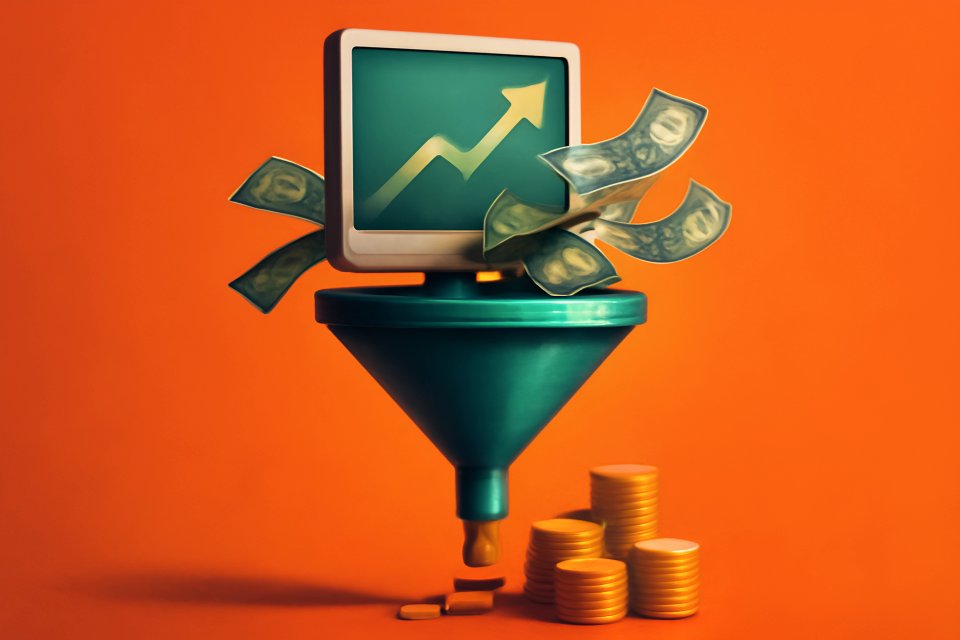
Are you tired of the grind? You’re running on three different treadmills at once—a freelance gig here, a blog there, maybe you’re trying to sell a digital template on the side. You’re constantly busy, your to-do list is a mile long, but your bank account doesn’t reflect the sheer effort you’re putting in. It feels like you’re spinning your wheels, with each hustle existing in its own lonely silo, completely disconnected from the others.
Here’s the secret the most successful digital creators won’t tell you outright. The goal isn’t just having multiple income streams; it’s having integrated ones. Imagine an income ecosystem where your freelance work naturally feeds your blog, your blog builds an audience for your affiliate links, and that audience is primed and ready to buy the digital products you create. This is a system where each part strengthens the others, creating a powerful flywheel that generates momentum, authority, and most importantly, financial security.
This isn’t another article telling you to simply "start a side hustle." This is your step-by-step blueprint for designing a resilient, diversified income portfolio that works smarter, not just harder. We’ll show you how to strategically combine your digital ventures, transforming your scattered efforts into a cohesive machine that builds wealth and protects you from the unpredictable nature of the online world.
Why a Single Income Stream is a Risk (And Why Siloed Hustles Aren't Much Better)
Let’s be brutally honest. Relying on a single source of income in the digital age is like betting your entire future on one roll of the dice. A single algorithm change, one lost client, or a shift in market trends can decimate your earnings overnight. According to the U.S. Bureau of Labor Statistics, about 20% of new businesses fail during the first two years of being open. Relying on one venture carries that same level of risk.
But simply adding more, disconnected hustles isn't the answer. Juggling a freelance career, a separate affiliate blog, and an unrelated e-commerce store creates burnout, not a safety net. The real power comes from integration, which creates a flywheel effect where success in one area accelerates growth in another. As Neil Patel explains, this synergy is what separates struggling hustlers from thriving digital entrepreneurs.
An integrated model does more than just protect your income; it builds undeniable authority. When your freelance clients see you have a popular blog with affiliate recommendations and a premium course on the very subject they hired you for, you’re no longer just a service provider. You become a recognized expert, a trusted authority whose value extends far beyond an hourly rate, allowing you to command higher prices and attract better opportunities.
The Core Components: Understanding Your Monetization Pillars
To build your ecosystem, you first need to understand its three foundational pillars. These aren't just random ventures; they are strategic components that serve a specific purpose in your overall income strategy. Each pillar supports the others, creating a structure that is both stable and scalable.
Pillar 1: Active Income (The Foundation)
This is where it all begins: direct-for-payment work. Think freelancing, consulting, or coaching. This pillar is your foundation because it provides immediate, predictable cash flow and, more importantly, it’s where you hone your core expertise and gather real-world case studies.
Your active income is the engine of your entire ecosystem. The problems you solve for clients become the inspiration for your content and the basis for your future digital products. This is the hands-on work that proves your methods are effective, giving you the credibility you need to build your other income streams. If you're just starting, exploring low-risk digital side hustles is the perfect way to establish this foundational pillar.
Pillar 2: Audience-Based Income (The Connector)
Next comes the pillar that connects your expertise to a wider audience. This includes revenue streams like affiliate marketing, sponsorships, or YouTube ad revenue. Here, you leverage the authority you built through your active income to generate semi-passive revenue by recommending products and services you genuinely use and trust.
This pillar is your bridge. It allows you to monetize your growing audience without having to create a product from scratch yet. As explained in guides on monetization models, affiliate marketing is a low-overhead way to earn commissions, turning your expert recommendations into a reliable income stream. This is where you transform your personal brand into a revenue-generating asset by learning how to monetize your blog with smart affiliate marketing strategies.
Pillar 3: Asset-Based Income (The Scaler)
This is the ultimate goal for true scalability and financial freedom. Asset-based income comes from creating and selling your own intellectual property, such as digital products, e-books, online courses, or even print-on-demand merchandise. Unlike your time, a digital asset can be sold an infinite number of times, decoupling your income from the hours you work.
This pillar is your wealth multiplier. It takes the expertise from your active income and the audience from your connector pillar and packages it into a product that generates revenue 24/7. As experts at Simon-Kucher note, the key is designing monetization models that align with customer value, turning your knowledge into a premium, scalable asset. This is where you can truly unlock passive income with strategies like print-on-demand.
The Integration Blueprint: How to Make Your Ventures Work Together
Understanding the pillars is one thing; making them work together is where the magic happens. This isn't a random process. It's a deliberate strategy of building bridges between your ventures so that each one makes the others more valuable.
From Freelancer to Affiliate
The most natural first step is to connect your active income to your audience-based income. As a freelancer, you already use and recommend tools, software, and resources to your clients. Why not get paid for those recommendations?
Start by creating a simple "Tools I Use" or "Resources" page on your professional website or blog. Populate it with affiliate links for the products you genuinely endorse. You can also include these links (with full transparency) in your client onboarding and offboarding documents, providing extra value while opening up a new revenue stream. This is the first step in building out successful affiliate marketing funnels.
From Freelancer to Product Creator
Listen closely to your clients. What questions do they ask you over and over again? What is the one problem you find yourself solving on every project? That recurring pain point is the seed of your first digital product.
Stop giving away your best processes for free. Turn that high-converting proposal template you designed into a low-cost product on Gumroad. Package the solution to your clients' number one challenge into a comprehensive e-book or a mini-course. This strategy transforms your service-based knowledge into a scalable asset, powered by a strong personal brand that generates revenue.
From Audience Builder to Product Seller
Your content—blog posts, newsletters, social media—is the engine for building trust and a loyal following. The most valuable asset you can build here is an email list. An email list is a direct line to your most engaged followers, a community you own, and the single most effective channel for launching your digital products.
Offer a valuable freebie, like a checklist or a mini-guide, that is related to the topics you discuss and the affiliate products you recommend. This lead magnet will entice readers to subscribe to your email list. From there, you can nurture that relationship with valuable content and eventually pitch your premium digital products to an audience that already knows, likes, and trusts you.
Case Studies: See How It Works in the Real World
Theory is great, but seeing these integrated monetization strategies in action makes it click. Here are two examples of how digital entrepreneurs combine the three pillars to create a powerful income ecosystem.
The first example is a freelance graphic designer who specializes in branding for tech startups. For her active income, she designs logos and brand guides. She then builds her audience by running a blog with design tutorials, where she uses affiliate links to recommend premium fonts, stock photo sites, and the design software she uses, creating a solid stream of audience-based income. Finally, she packages her expertise into an asset: a "Brand Identity Kit" template she sells on Gumroad for new businesses that can't afford her full freelance package.
| Income Pillar | The Freelance Graphic Designer | The Virtual Assistant for Coaches |
|---|---|---|
| Active Income | Designs logos for tech startups | Manages scheduling for life coaches |
| Audience-Based Income | Blog with affiliate links for fonts & software | Instagram with affiliate links for Asana/ClickUp |
| Asset-Based Income | Sells a "Brand Identity Kit" template | Sells an "Organized Coach's System" course |
Our second example is a virtual assistant (VA) who works with life coaches. Her active income comes from managing their schedules and email inboxes. To build her audience, she shares productivity tips on Instagram and recommends project management software like Asana and ClickUp through affiliate links. Seeing a common need among her clients, she creates her asset: a scalable online course called "The Organized Coach's System," which she sells to other coaches who want to implement her methods themselves.
Your Tech Stack for a Streamlined System
Managing an integrated income ecosystem requires the right tools to keep things running smoothly without causing burnout. A well-chosen tech stack automates repetitive tasks and gives you a clear view of your entire business. Building efficient productivity systems is key to managing multiple income streams effectively.
Your most critical tool is an Email Marketing platform like ConvertKit or MailerLite. This is how you will build and nurture your audience, which is the lifeblood of your audience-based and asset-based income pillars. For selling your digital products, you'll need a Digital Product Hosting platform like Gumroad, Podia, or Teachable to handle payments and delivery seamlessly.
To optimize your affiliate revenue, an Affiliate Link Management tool like ThirstyAffiliates or Lasso is essential for organizing, tracking, and cloaking your links. Finally, to keep all the moving parts of your ecosystem in order, a Project Management tool like Notion or Trello is non-negotiable. It will serve as the central command center for your content calendar, product launches, and client work.
Start Building Your Resilient Income Future Today
Let the message sink in: it's time to stop juggling disconnected hustles and start building a smart, integrated income ecosystem. The goal is no longer just diversification; it's synergy. It's about creating a system where your efforts compound, building a business that is resilient, authoritative, and truly scalable.
Building this system is a strategic journey, not an overnight project. But financial freedom is a learnable skill, and you now have the blueprint. The first step is the most important: choosing your foundational skill and building your first pillar. From there, you can begin weaving the connections that will transform your hard work into lasting wealth.
Ready to map out your own income ecosystem? Download our free Integrated Monetization Map Worksheet to brainstorm how your skills can connect across all three pillars. For a tactical plan, use The Ultimate Checklist for Building a Multi-Stream Income Portfolio to turn this strategy into action.
What's your foundational skill? Share in the comments below how you plan to build your first integration














